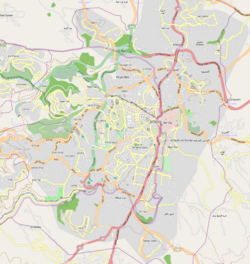Israelite Tower
| Alternate name | המגדל הישראלי |
|---|---|
| Coordinates | 31°46′35.09″N 35°13′54.62″E / 31.7764139°N 35.2318389°E |
| Type | fortification |
| History | |
| Material | stone |
| Founded | 8/7th century BCE |
| Abandoned | 586 BCE |
| Periods | Iron Age, Hasmonean |
| Site notes | |
| Excavation dates | 1969-1982 |
| Archaeologists | Nahman Avigad |
| Public access | limited |
The Israelite Tower (Hebrew: המגדל הישראלי) is an archaeological site in Jerusalem's Jewish Quarter. The site features remains of the city's Iron Age fortifications which were later incorporated into the Hasmonean city walls. It was excavated by Israeli archaeologist Nahman Avigad during the 1970s. Finds unearthed at the site attest to the Babylonian destruction of Jerusalem in 586 BCE.
Between 1969 and 1982 Nahman Avigad conducted extensive excavations in the Jewish Quarter, situated on Jerusalem's southwestern hill. These excavations, covering an area of some 5 acres, proved crucial for the understanding of the history of settlement in this section of the old city. In the northern part of the quarter, Avigad and his team uncovered three well-preserved segments of late Iron Age (First Temple Period) fortifications. One of these was the Israelite Tower, described as "one of the most impressive fortification remains from biblical times to have been found in the land of Israel".
Slightly north of the Broad Wall, excavations revealed two perpendicular walls about 4 metres (13 ft) wide and surviving to a maximal height of 7 metres (23 ft). One is 12 metres (39 ft) long, running from east to west, and the other 8 metres (26 ft) long and runs from north to south. Standing on bedrock 45 feet below modern ground level, the walls were built of rough-hewn field stones placed in courses along both faces, with the spaces in-between filled with small stones. A surface of beaten earth tightly bonded to the tower, covered by ashes, produced Late Iron Age II sherds characteristic of the 8th and 7th centuries BCE. Avigad identified the tower as the corner of a four-chambered gatehouse in Jerusalem's northern wall, perhaps the "Middle Gate" mentioned in Jeremiah 39:3. It had been built to protect the city's vulnerable northern perimeter, probably during the 8th century BCE but perhaps during the reign of Menasseh in the 7th century BCE. It is physically close to the Broad Wall, built during the reign of king Hezekiah, but appears to have come into use after the Broad Wall had already fallen into disuse.
...
Wikipedia

